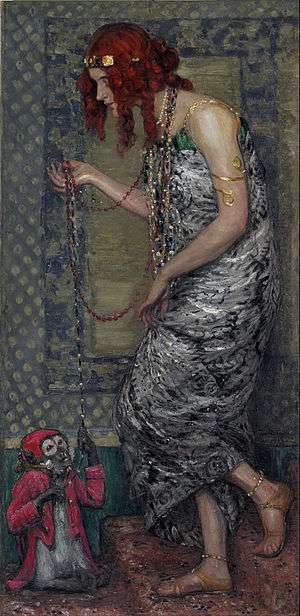Janis Rozentāls
| Janis Rozentāls | |
|---|---|
 | |
| Born |
18 March 1866 Saldus parish, Courland Governorate, Russian Empire |
| Died |
26 December 1916 (aged 50) Helsinki, Grand Duchy of Finland, Russian Empire |
| Nationality | Latvian |
| Known for | Painting |
| Movement | Impressionism, Art Nouveau |
Janis Rozentāls (March 18, 1866 – December 26, 1916) was a famous Latvian painter.[1]
Life
Rozentāls was born in Bebri Farmstead, Saldus parish, Courland Governorate in the Russian Empire. He was the son of a blacksmith. He received the basic education at H.Krause's Elementary School in Saldus and Kuldīga District School. At the age of fifteen he left for Riga and consistently tried to realize his dream about art, later entering Saint Petersburg Academy of Arts. During study vacations the developing artist visited his native land to relax from the hectic rhythm of the large city, paint motifs from nature and commissioned portraits. For his diploma work he took as models the young educated Latvians and local farmers.
A little later the artist decided to settle in Saldus as he wanted to live among his people and create art appropriate to its aspirations and feelings. In spring 1899 Rozentāls bought a building plot at the Striķu street and set up a studio, but his intents were not well received in the provincial town, and he moved to Riga two years later. Now a memorial museum is arranged in the building designed by the artist. Fateful turn in life of the painter happened in November, 1902, when Janis Rozentāls got acquainted with Elli Forssell (1871–1943), a Finnish singer, in Riga. On February 20, 1903, they got married. They found home in a flat- studio, in Alberta street, in Riga. They had three children – Laila, Irja and Miķelis.
World War I interrupted the family's life in a villa in Kulosaari, Helsinki where they lived from 1905 to 1916.
While coming from exhibition in Moscow he got ill and died on December 26, 1916 in Helsinki. He was buried in Hietaniemi Cemetery, though later was reburied in Forest Cemetery in Riga in 1920. Today, the Janis Rozentāls Art Highschool in Riga is named after him, and has had his name since 1946.[2]
Creative work
The scope of Rozentāls' activities was very wide, but painting was of paramount importance. He revealed the beauty of nature, demonstrated the integrity of man and nature. In Rozentāls' works the linear coexisted with the picturesque, flatness – with a soft transition of tones, small touches of paint – with wast surfaces of color. The main trait of his compositions was asymmetry, the wavelike rhythm of Art Nouveau.
Rozentāls painted many portraits. The creative potential of the artist revealed itself in the portraits of persons spiritually close to him. Rozentāls made several portraits of the patron of writers and artists A.Dombrovskis, writer Rūdolfs Blaumanis, artist's wife Elli Forsell.
Janis Rozentāls interested in the biological nature of man – the world of passions, the love theme, was typical of his time. He used the popular Biblical plots "Temptation", "Eve with the Apple", motives from the mythology and observations of the reality of his time. At least a part of the fantastic images possessed both, contemporary and local, and individual symbolic meaning.
Artist turned to landscape painting as well, and created a lyrical image of the motherland in the Latvian art. His favorite season was spring, the rebirth of Nature. J.Rozentāls made several altar-pieces to order in the churches of Latvia. In his altar-pieces Rozentāls omitted the dynamics, expressiveness, texture and finished composition. He took into consideration the understanding of art of the simple people and adapted himself to it, yet at the same time he tried not to lose the artistic quality.
The artist tried his skills in monumental painting. In the summer of 1910 he worked at the decorative frieze on the facade of the newly erected building of the Riga Latvian Society. He painted seven symbolic compositions characterizing the main activities of the society.
Painting occupied a central place in the creative activity of Janis Rozentāls, yet his performance in graphic art was significant, too. The scope of his activity was very wide – the design of books and magazines, applied graphic art, posters and drawings.
The characterization of Janis Rozenāls' personality would not be exhaustive without a review of his social activity. During his study years he took part in the life of the Academy of St. Petersburg. Later he devoted much effort to the consolidation of Latvian artists, who were neglected in their native land. He was a member of jury of almost all the biggest Latvian art exhibitions. Rozentāls took part in the organization of the exhibitions of Latvian art outside Latvia.[3]
Gallery
 Monument of Janis Rozentāls in Saldus
Monument of Janis Rozentāls in Saldus Nāve (Death) (1897)
Nāve (Death) (1897) Porch in the Capri (1912)
Porch in the Capri (1912) Italian Landscape (1915)
Italian Landscape (1915) Family in the Sigulda (1913)
Family in the Sigulda (1913) From the Cemetery (1895)
From the Cemetery (1895) After Church (1894)
After Church (1894) Picnic (1913)
Picnic (1913) Self Portrait (1900)
Self Portrait (1900) Portrait of Writer Rūdolfs Blaumanis (1908)
Portrait of Writer Rūdolfs Blaumanis (1908) Portrait of Mērija Grosvalds (1902)
Portrait of Mērija Grosvalds (1902) Portrait of Charlotte von Lieven (1899)
Portrait of Charlotte von Lieven (1899) The Princess and the Monkey (1913)
The Princess and the Monkey (1913) Black Snake (1903)
Black Snake (1903) Women and the Spirits of Nature (1907)
Women and the Spirits of Nature (1907) The Painter’s Studio (1896)
The Painter’s Studio (1896) Daughters of Sun (1912)
Daughters of Sun (1912) Men with a Russian Cigarette (1901)
Men with a Russian Cigarette (1901) Portrait of M.Vīgnere-Grīnberga (1916)
Portrait of M.Vīgnere-Grīnberga (1916)
| Wikimedia Commons has media related to Janis Rozentals. |